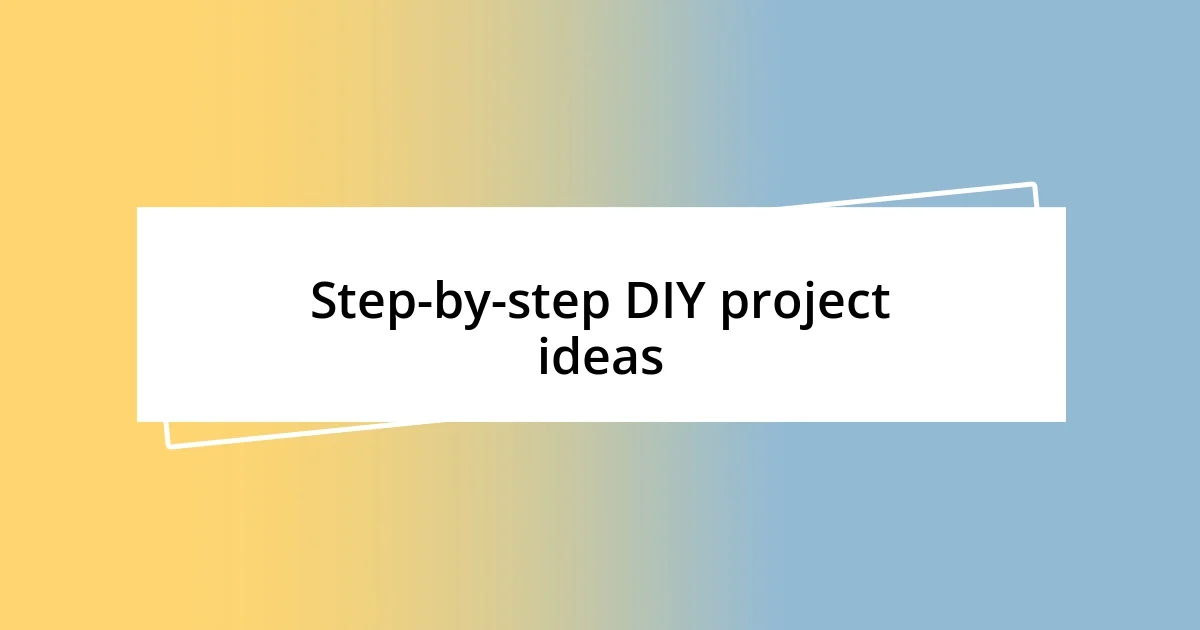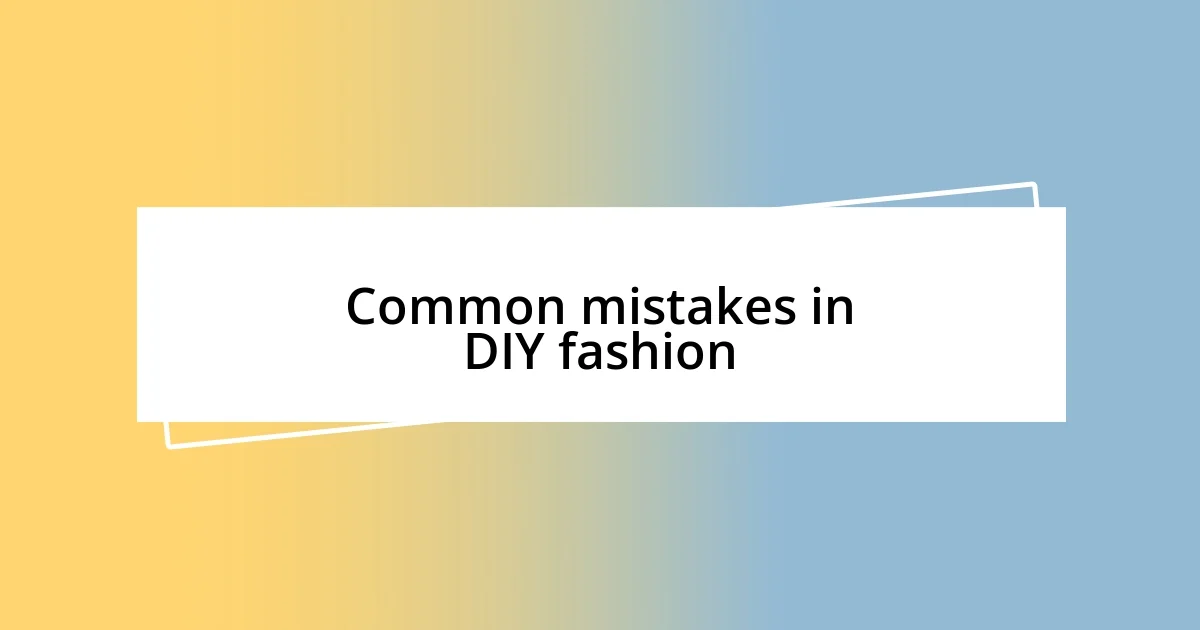Key takeaways:
- DIY fashion encourages creativity and personal expression, allowing individuals to transform old garments into unique pieces, fostering a sense of empowerment.
- Engaging in DIY projects promotes sustainability by reducing waste and encouraging intentional consumption, while also nurturing community through shared experiences.
- Successful DIY endeavors benefit from thorough planning, suitable fabric selection, and the embrace of imperfections, which enhances satisfaction and the creative process.

What is DIY fashion
DIY fashion, or “do-it-yourself” fashion, is all about creating and customizing your wardrobe to reflect your personal style and creativity. I still remember the first time I took an old pair of jeans and transformed them into trendy cut-offs. It felt incredibly empowering to take something I thought was outdated and turn it into a fashionable piece I loved.
For many, DIY fashion also serves as a creative outlet—an escape from the conformity of mass-produced clothing. Have you ever looked in your closet and felt uninspired? Personalizing or upcycling clothing not only helps express individuality but often carries sentimental value. For instance, I once tailored a friend’s old T-shirt into a chic tote bag, preserving the memory while giving it new life.
At its core, DIY fashion invites us to embrace our skills, imagination, and resourcefulness. It challenges us to ask: why settle for what’s available when we can craft something uniquely ours? This mindset shifts the focus from consumption to creation, promoting sustainability and appreciation for the art of fashion itself.

Benefits of DIY fashion
The beauty of DIY fashion lies in its ability to foster creativity and personal expression. Every time I breathe new life into an old garment, it’s like rediscovering a hidden part of myself. For example, I once turned a plain black dress into a stunning piece by adding colorful embroidery—the process was therapeutic, almost meditative. It was not just about the end result but the joy of creation itself that made it worthwhile.
Moreover, DIY fashion promotes sustainability by encouraging us to think critically about consumption. It often leads to a more intentional approach to our wardrobes. When I started making my own accessories from fabric scraps, I realized how much I was saving from landfills while making something beautiful. Who knew that an old t-shirt could become a unique pair of earrings? This kind of innovation makes my heart swell with pride.
Lastly, engaging in DIY fashion nurtures a sense of community. Sharing projects and ideas with friends can spark inspiration and foster collaboration. I remember hosting a button-making party where friends brought old clothing items. Together, we created one-of-a-kind designs! Whether we were strategizing or just enjoying each other’s company, it deepened our connections and made the experience all the more meaningful.
| Benefits | Details |
|---|---|
| Creativity | Enhances personal expression and allows innovative designs. |
| Sustainability | Promotes responsible consumption and reduces waste. |
| Community | Fosters connections through shared projects and collaboration. |

Essential tools for DIY fashion
To successfully embark on DIY fashion projects, having the right tools is essential. I can’t emphasize enough how much a simple pair of fabric scissors can elevate your crafting experience. I vividly recall one moment when I attempted to sew a dress while struggling with dull scissors—it turned into a frayed mess! Investing in the right tools truly makes the journey of creation smoother and more enjoyable.
Here are some essential tools that can help make your DIY fashion projects easier and more enjoyable:
- Quality Fabric Scissors: Sharp and precise for clean cuts.
- Sewing Machine: Great for quick and professional finishes.
- Rotary Cutter & Mat: Ideal for cutting straight lines and intricate designs.
- Needles and Threads: Variety in types is crucial for different fabric weights.
- Measuring Tape: Always handy for accurate measurements.
- Pins and Clips: Essential for holding pieces together before sewing.
- Fabric Glue: Perfect for quick fixes and no-sew projects.
- Seam Ripper: A lifesaver for correcting mistakes!
With these tools in hand, your DIY projects become much more feasible! Just thinking back to the time I was trying to sew a bag without a seam ripper—I spent hours trying to fix my blunders until I learned its value. The right tools transform not just the end result but also the experience of creating something uniquely yours.

Step-by-step DIY project ideas
Starting a DIY fashion project can be both exciting and daunting, but I find that breaking the process down into manageable steps really helps. For a simple yet stunning upcycle, take an old pair of jeans and turn them into a stylish tote bag. First, cut the jeans to your desired length. Then, use the fabric from the legs to make straps. I remember feeling a rush of creativity as I stitched the pieces together, realizing I was crafting something functional from what was once destined for the closet abyss.
Another engaging project is creating DIY embellished sneakers. Start with a basic pair and gather your embellishment materials—think studs, lace, or fabric paint. I once spent an entire evening decorating a pair of white canvas shoes with vibrant floral patterns. Each stroke of paint felt like an expression of my personality. It’s such a rewarding experience when you wear your customized sneakers and see heads turn. Who knew investing a few hours could yield such a unique statement piece?
If you’re looking for something quick and impactful, consider making fabric-covered bookmarks. Start with a piece of sturdy cardstock as a base, and cut your fabric scraps to size. Then, glue the fabric onto the cardstock, folding the edges over for a neat finish. One afternoon, I made a series of these bookmarks as gifts for friends, each one reflecting their personality through the fabric choice. It was gratifying to create small tokens of appreciation that were both beautiful and functional. Have you ever experienced the joy of gifting something handmade? That feeling is truly special!

Common mistakes in DIY fashion
One of the most common mistakes I’ve seen in DIY fashion is skipping the planning phase. I remember diving headfirst into a project without sketching out my ideas or taking measurements. It resulted in a garment that was about two sizes too big and just didn’t sit right. Taking a moment to brainstorm and plan makes a world of difference. Have you ever found yourself with a finished piece that just doesn’t work? Trust me; it’s worth the extra effort to map it out first.
Another pitfall is underestimating the importance of fabric choice. There were times early in my DIY journey when I was drawn to visually appealing fabrics without considering how they would perform in a project. For example, I once attempted to make a flowy summer dress out of a stiff canvas—definitely not the right choice! My enthusiasm fizzled when the dress ended up looking awkward and unflattering. Choosing the right fabric can elevate your project from mediocre to fabulous, so always think about function alongside aesthetics.
Lastly, I can’t emphasize enough the value of patience. I once tried to rush through sewing a pair of pants, just eager to wear them. The result? Wonky seams and a lot of unpicking stitches. It taught me that quality over speed is crucial. Have you ever been frustrated because you rushed a project? Taking your time ensures that the final result reflects the effort and creativity you poured into it.

Tips for successful DIY projects
When embarking on a DIY fashion adventure, I’ve discovered that gathering all your materials before you start can dramatically improve your experience. I remember a project where I was halfway through sewing a jacket when I realized I had forgotten the buttons. It disrupted my flow, and I ended up feeling frustrated when I should have been enjoying the creativity. Have you ever had a similar experience? Dedicating a few minutes to organize your workspace and materials can help keep that creative energy flowing.
One piece of advice I cherish is to embrace imperfections. I once dyed an old shirt a vibrant teal, only to find a few spots that didn’t take the color evenly. Instead of being upset, I turned those uneven patches into an unexpected design element. Now, that shirt is one of my favorites because it tells a story about my DIY journey. It’s a reminder that the beauty in these projects often comes from their quirks. So, why not celebrate those happy accidents?
Lastly, always be open to learning as you go. Early in my DIY days, I followed a tutorial to a tee, hesitating to experiment. But, through practice, I learned to make adjustments based on my preferences. I remember altering a simple dress design into something uniquely mine, and it felt empowering to trust my instincts. How often do we hold ourselves back from creative expression out of fear? Embracing trial and error not only enhances your skills but also fuels your creative confidence.












